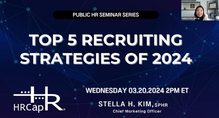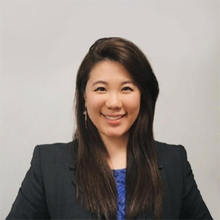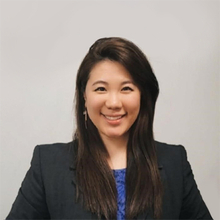
최신기사
HRCap, ‘톱5 채용 비법’ 세미나 성황리 개최
글로벌 HR컨설팅 및 서치펌인 HRCap이 20일 채용에 어려움을 겪는 기업들을 위해 '톱5 채용 비법' 온라인 인사 세미나를 무료로 진행했다. 이번 세미나는 최근 많은 기업이 채용에 어려움을 겪고 있다는 점에 착안했다. 지난해에는 전 세계 77% 기업이 채용에 어려움을 겪은 것으로 파악됐다. 미국에 진출한 한국 기업과 미주 한인 회사들도 팬데믹 이전보다 전문직 채용과 한인 인재 확보가 더 어려워진 것 같다고 입을 모으고 있다. 이날 스텔라 김 HRCap 전무(북미사업총괄)는 세미나에서 기업들이 부족한 인력풀에 대응하고, 잡마켓에 수동적인 인재(Passive Candidate)에 접근하는 방법에 관해 설명했다. 또한 에이스 후보자를 발굴하고 설득하기 위해 이들이 만족할만한 기업 가치를 제공하고, 만족할만한 베니핏을 제공함과 동시에 커리어적으로 발전할 기회를 제시할 수 있도록 해야 한다고 전했다. 기업이 구직자들과 소통하는 플랫폼을 다양화하고, 후보자들에게 긍정적인 인터뷰 경험을 줄 수 있도록 할 것을 당부했다. 기업이 브랜드 가치를 스스로 높이는 것도 중요한 포인트로 꼽았다. 이날 세미나에는 75명이 참석해 양질의 후보자를 채용할 수 있는 방법을 듣는 유익한 시간을 가졌다. 김은별 기자 [email protected]세미나 성황리 세미나 성황리 인사 세미나 hrcap HRCap hr캡 스텔라김 stellakim
2024.03.21. 18:01

[전문가 칼럼] 헤드헌터의 비밀, 이직하기 제일 좋은 시기
이직하기 제일 좋은 시기는 과연 언제일까? 노동통계국 데이터를 보면, 1월 그리고 8월에 이직률이 제일 높다는 것을 알 수 있다. 연말 보너스를 받고 바로 퇴사(Bonus Bounce)하며, 여름 슬럼프(Summer Slump)에 빠져 새로운 변화를 위해 이직한다. 포브스 등은 2024년 1월에 20년만에 최대 규모의 대퇴사(January Exodus) 또한 예상하고 있다. 통상적으로는 연말 이직을 결심하는 이들이 제일 많다. 새해가 다가오면 변화를 고민하며 몇 년 정도 경력을 쌓고 떠나면 좋은지, 기업들이 채용을 제일 많이하는 시기가 언제인지, 이직 준비는 얼마나 오래해야하는지 질문하는 경우가 많다. HRCap 2000-2023 후보자 퇴사사유 설문조사 분석에 따르면 ▶연봉 ▶조직문화 ▶업무적성 ▶회사비전 ▶상사 혹은 동료와의 불화 때문에 대부분 이직을 결심한다. 연말성과평가에 동의하지 못 하거나, 승진·보너스·연봉인상 등을 제대로 받지 못 해 불만을 갖고 과감하게 퇴사를 결정하는 경우도 있다. 연초에 채용기회가 높은 것 또한 사실이다. 기업들은 대부분 11월에 예산지출을 마무리하고, 12월에는 내년도 사업계획 달성을 위한 조직도를 편성해 1월과 2월 신규 임직원을 적극적으로 채용한다. 연말 연초에 많은 이들이 퇴사해 공석이 발생하는 만큼, 취업 및 이직자들에게 더 많은 기회가 주어지기도 한다. 물론 잡마켓 중심에 있는 리크루터, 헤드헌터 입장에서는 취업 및 이직희망자들에게 언제 어디서든 자신의 몸값인 마켓밸류(시장가치) 향상과 미래 가치창조를 위해 긍정적으로 준비해야 한다고 권고하는 게 당연한 듯 하다. 다만 몸값 향상만을 위한 이직준비가 아닌, 현 직장에서 자신의 가치제안(Value Proposition)과 경력 포트폴리오(Career Portfolio)를 갈고 닦는 데 더욱 집중하고 매진해 회사 성장발전에 한몫하라는 조언을 더 아끼지 않고 있다. 우선 본인이 연봉에 준하는 역량을 실제로 보유하고 있는지 그만큼 기대한 개인 및 조직성과를 내고 있는지 파악해 보고, 성과달성이 미진한 이유가 조금이라도 본인에게 있는지 살펴봐야 한다. 업무가 많을 때 우선순위부터 업무처리하는 선택과 집중의 방식을 익히고, 회사 성장에 기여하는 부분을 호기심을 갖고 고민해보는 것을 추천한다. 오너십을 갖고 꾸준히 학습하며 회사와 개인이 동반성장해야 한다는 것도 잊지 말아야 한다. 잦은 잡호핑(Job-Hopping)으로 성장과 새로운 경험을 추구하는 이들이 많기 때문에, 이직이 잦은 후보자들보다 한 곳에서 다양한 경력을 쌓고 성장하는 인재를 귀하게 여기고, 회사 속에서 가치있는 미래성장을 주도하는 리더에게 아낌없이 투자하는 기업만이 살아남을 수 있다는 현실세계도 반드시 알아야만 한다. 헤드헌터의 입장에서 최고의 후보자는 적극적으로 이직을 준비하는 자가 아닌, 본인의 가치를 잘 알면서 현직에 충실하여 성과와 변화를 공유하고 주도하는 인재다. 새로운 기회를 외부에서 찾기보단, 현재 자리에서 찾아 만들어야만 회사가 성장하고 자신이 성공했다고 자부할 수 있기 때문이다. 즉 이직하기 제일 좋은 시기는 아직 오지 않았다. 내면을 강화시켜 갈등과 고난을 극복할 수 있는 단단하면서 질긴 그릇이 될 때, 예상하지 못한 시점에, 당신이 거부할 수 없는 참 기회로 연락이 곧 올 것이다. 스텔라 김 / HRCap, Inc. 상무(Chief Marketing Officer) ━ [Expert Column] A Headhunter’s Secret Is Out – The Best Time to Change Jobs The best time to switch jobs comes only when we invest internally When is the best time to change jobs? According to the Bureau of Labor Statistics, the average annual quit rate is the highest in January and August. Employees often “Bonus Bounce,” leaving right after their end-of-year bonuses, fall into “Summer Slumps,” and seek change through new career opportunities. Forbes predicts that the largest resignation in 20 years will occur in January 2024, the “January Exodus.” Generally, the end of the year is the most common time people consider a job change. As the new year approaches, many seek advice on how much prior experience is sufficient to change jobs, and how long they should effectively prepare for the job change. According to the HRCap 2000-2023 Candidate Survey analysis, the most common reasons for leaving the current workplace are due to misalignment in salary, company culture, roles and responsibilities, company vision, and relationships with managers or colleagues. Some ultimately decide to leave in disagreement with their end-of-year performance review results, or because they are dissatisfied about not receiving promotions, bonuses, or annual salary increases. The hiring pipelines are also much more robust at the beginning of the year. Companies usually finalize their budgets in November, conduct organizational planning in December, and then actively recruit in January and February to achieve their business goals in the coming year. As many vacancies are created through high turnover at the beginning of the year, many more opportunities are opened up for job seekers as well. From the perspective of a recruiter and headhunter at the center of the job market, it only seems fitting to advise job seekers to always be prepared for a job change to raise their market value. However, rather than changing jobs just for the sake of raising market value, we advise candidates to focus on refining their value proposition and career portfolio instead. First, candidates should assess whether they actually have the competencies equivalent to their annual salary and whether they are performing up to individual and organizational performance expectations. We recommend learning how to efficiently streamline and prioritize tasks when overwhelmed with a higher workload to stay productive and effective. Both companies and individuals must take accountability for continuous learning and collective growth. With so many job hoppers in the market, employers now value employees who continue to show commitment and growth above candidates who interview well for new opportunities. They are also proactively investing in leaders with demonstrated ability to futureproof the workplace. From a headhunter’s point of view, ideal candidates are not ones that actively interview. Rather, they are those who understand their own value add, remain faithful to their current organization, and strive to consistently grow. It's only by finding transformational opportunities in their current position rather than looking outside, that these top professionals can confidently say that they have truly achieved meaningful success. The best time to change jobs is yet to come. Only when we take the time to invest in developing our inner selves, when we become an unbreakable vessel able to overcome any conflicts and hardships, and when we are least expecting it, the right opportunity will come to find us instead. Stella H. Kim, SPHR HRCap – SVP, Head of Americas & Chief Marketing Officer 전문가 칼럼 헤드헌터 비밀 연말 이직 리크루터 헤드헌터 이직 준비 스텔라김 hrcap hr캡 stellakim 이직
2023.12.20. 21:35

[전문가 칼럼] 세대 갈등 7단계로 풀기
미국에서도 세대갈등 문제가 점점 심각해지고 있다. 개인관계, 가정, 직장 그리고 사회에서 세대간 갈등이 많이 발생하고 있다. 상사와 부하직원 간의 갈등으로 인한 퇴사, 부모 자녀 간의 갈등으로 인한 대화 단절, 그리고 나이차별이라는 용어도 생겨났다. 세대갈등을 사회적 지위와 관계에 따른 힘과 정책으로 풀어나간다면 이는 진정한 해결책이 아니다. 보이는 부분만 해결한다면 이는 미봉책이며, 오히려 더 심각해질 수 있다. 갈등은 피할수록 더 독이 되기 때문이다. 이를 지혜롭게 해결할 수는 없을까? 세대, 나이로 인해 발생하는 갈등에너지를 긍정적인 방향으로 전환하고 현명하게 극복할 수 있는 방법이 있지 않을까? HRCap '7A Conflict Resolution Model' 을 적용, 7가지 단계별 행동을 따르면 수많은 갈등 상황을 잘 극복할 수 있다. 1. Accept – 많은 사람들이 놓치고 있는 부분으로, 그 갈등을 해소하고 극복하겠다는 진정한 태도다. 열린 마음으로 상황을 받아들이고, 책임감을 갖고 상대방과 갈등관계를 해소하길 원하는 진정성이 있어야 한다. 2. Acknowledge – 소통을 통해 상대를 이해하고 갈등을 인지해야 한다. 피하지 말고 정확하게 현재의 상황과 현실을 인식할 수 있도록 귀를 기울여야 한다. 3. Assess – 갈등상황의 원인과 문제점을 파악하고 분석해야 한다. '무엇'이 문제인지 보다는 '왜' 갈등이 생겼는지에 초점을 두고, "그럴수도 있겠구나"하며 상대방의 관점에서 바라보는 것이 필요하다. 4. Appreciate – 공감대를 형성해 서로가 다름을 존중해야한다. 본인의 부족한 점을 인정하고 상대방의 장점에 집중해야 한다. 갈등의 원인을 파악해 또다른 갈등, 그리고 수면 아래에 있던 문제들로 발생 가능한 상황도 미리 방지하는 계기가 됐음에 감사해야 한다. 5. Align – 본인과 상대방의 요구사항을 충족하고 수용할 수 있는 범위 내에서 최대한 맞출 수 있도록 함께 노력해야한다. 서로가 만족할 수 있는 솔루션을 만들기 위해 끊임없이 소통하며 간극을 줄여야 한다. 6. Adapt – 꾸준한 노력을 통해 도출한 솔루션에 적응하도록 해야한다. 서로 조금씩 손해보면서 배려하고 맞춰나가면 결국 서로에게 득이 된다. 7. Advance – 변화를 통해 발전해야 한다. 상황과 관계, 그리고 본인 자신이 변하고 발전해야 그 갈등을 충분히 극복했다고 볼 수 있다. 시대의 변화, 세대간 경험 및 가치관 차이, 엄청난 속도의 기술 발전으로 세대간의 갈등은 불가피하다. 중요한 것은 이 세대간의 갈등을 어떻게 풀어나갈 것인가다. 고정관념과 편견을 갖고 구별짓기보다는, 세대차이가 아닌 '세대가 다른 개인의 차이'로 인식하며 다양한 배경, 경력, 사고방식을 존중해야 한다. 갈등을 성장의 기회로 삼아 공존하고 함께 발전하는 길을 걸어야 한다. 결국 우리는 소통해야 한다. 불만을 지혜롭게 이야기하고, 현명하게 극복해야 갈등을 건설적으로 해결할 수 있다. 그래야 성공은 물론, 삶의 질이 높아진다. 생각이 깊어지고, 마음의 여유가 생기고, 내면이 단단해져서 기업이 반드시 뽑아야만 하는 인재, 같이 일해보고 싶은 동료, 모시고 싶은 리더, 선한 영향력을 가진 지인, 언제든 함께하면 행복한 사람이 될 수 있을 것이다. 스텔라 김 HRCap, Inc. 상무(Chief Marketing Officer) ━ [Expert Column] 7 Actionable Steps to Resolving Generational Conflicts 〈 Applying the HRCap 7A Conflict Resolution Model 〉 Generational conflicts have progressively become a serious concern in the United States. They exist in personal relationships, households, organizations, and our greater society. Generational conflicts have led to resignations at workplaces and complete communication barriers among family members. Even the term “age discrimination” has emerged. Generational conflicts cannot be resolved through policy enforcement or power coercion based on statuses and hierarchies. This would only be superficially addressing and clouding the issue, thereby further aggravating the conflict at hand. Conflicts become even more toxic if avoided. That said, how can we resolve these conflicts constructively and wisely? How do we transform the negative energy caused by generational conflicts into a positive source of growth? We can apply the ‘HRCap 7A Conflict Resolution Model,’ a seven-step actionable guideline, to effectively approach and resolve the varying conflicts in our lives. 1. Accept - Many oversee this critical step. We must first have the genuine desire to resolve and overcome the conflict. Accept the situation with an open mind, be sincere in our approach, and take full accountability to resolve the conflict. 2. Acknowledge - Instead of dismissing or avoiding the conflict, we must acknowledge the conflict by leaning in. Communicate openly and listen carefully to truly recognize the situation and understand the reality. 3. Assess - We must identify and assess the cause of the problem. Focus on understanding ‘why’ the conflict happened rather than looking at ‘what’ the problem is. Take a step back to see it from the other’s perspective and be able to think, “I see your point,” “That’s fair enough,” “I can understand.” 4. Appreciate - We must learn to sympathize and appreciate our differences. Recognize our own shortcomings, and celebrate the other’s strengths. Be grateful that we are able to address other underlying issues and prevent future conflicts by identifying the root of the conflict. 5. Align - We must have alignment. Continuously communicate to reduce the gap. Build consensus by deliberating on the requirements, and accommodate to collectively reach a reasonable solution. 6. Adapt - We must consistently make an effort to adjust and adapt to reach the derived solution. It’s okay for each to take a slight loss for the greater benefit of all. 7. Advance - We must advance through change. The conflict can only be considered truly resolved should there be effective change and proper development in the situation, the relationship, and our own selves. Generational conflict is inevitable given changes with times, differences in values, varying experiences across generations, and rising advancement of technologies. The essence is being able to approach and solve these conflicts by learning to empathize and honor the differences. Instead of simply stereotyping and imparting biases, we must be able to look at generational differences as, in fact, “individual differences of those from different generations.” We must accept conflicts as growth opportunities in disguise. Only then can we walk the path of coexistence and collective growth. As such, we must learn to communicate. We need to productively express our dissatisfaction and constructively overcome conflicts. This will not only allow us to be more successful, but also live more meaningfully with deeper perspectives, a heart full of grace, and stronger self-worth. We must strive to become the talent companies compete to hire, the colleague peers ask to collaborate with, the respected leader employees wish to work under, the acquaintance that allows positive influence, and the person that always radiates gratitude and happiness. Stella H. Kim, SPHR | HRCap - Chief Marketing Officer & Global VP hrcap 칼럼 전문가칼럼 세대차이 세대갈등
2023.03.15. 21:41
